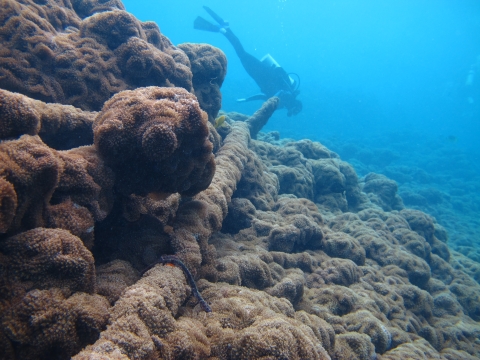Visit Us
Public access to Palmyra Atoll is self-limiting due to the very high expense and difficulty of traveling to such a remote destination. The Nature Conservancy owns and operates the only airplane runway on Palmyra and by boat, it's a five to seven day sailing trip from Honolulu.
There are four ways the public may gain access to the refuge:
- Working for, contracting with, or volunteering for The Nature Conservancy or Fish and Wildlife Service
- Conducting scientific research via Fish and Wildlife Service Special Use Permits
- Invitation through The Nature Conservancy sponsored donor trip
- Visitation by private recreational sailboat or motorboat
With prior approval by the USFWS, privately owned vessels are permitted access to the atoll for up to seven days to see and enjoy the natural resources of the refuge. A maximum of two vessels are allowed at one time and no more than six vessels may visit in a single month. As no dumping of any kind is allowed within the refuge, private vessels must have sufficient holding tanks for all black and gray water to accommodate their needs throughout the entire length of stay. Vessels are required to provide documentation of a hull bottom inspection and cleaning showing the absence of any marine organisms that is dated within two weeks of their departure for the refuge. Additional documentation of an inspection citing no signs of a rodent presence detected must be completed within 48 hours of departure for the atoll. The refuge is only open for visitation when an USFWS manager is present. As our staff is very small at this time we are only able to open the refuge to visitation for about six months each year, primarily in the summer months. Contact the refuge manager to discuss times the refuge will be open to visitors. No pets (e.g. dogs and cats) are allowed on the refuge even if they remain aboard the vessel.
Access to Cooper Island must be arranged and secured through The Nature Conservancy. Contact the deputy director of The Nature Conservancy’s Palmyra Program at palmyra_admin@tnc.org for further information.
Activities
Sailing and Boating
With prior approval, privately owned vessels are permitted access to the atoll for up to seven days to see and enjoy the natural resources of the refuge. A maximum of two vessels are allowed at one time and no more than six vessels may visit in a single month. As no dumping of any kind is allowed within the refuge, private vessels must have sufficient holding tanks for all black and gray water to accommodate their needs throughout the entire length of stay. Vessels are required to provide documentation of a hull bottom inspection and cleaning showing the absence of any marine organisms that is dated within two weeks of their departure for the refuge. Additional documentation of an inspection citing no signs of a rodent presence detected must be completed within 48 hours of departure for the atoll. The refuge is only open for visitation when an USFWS manager is present. Contact the refuge manager to discuss times the refuge will be open to visitors. No pets (e.g. dogs and cats) are allowed on the refuge even if they remain aboard the vessel.
Wildlife Viewing
There are excellent snorkeling and bird watching opportunities within the atoll. For those bringing their own equipment, SCUBA diving may also be permitted under certain conditions. Additionally, paddle boarding and kayaking are also excellent ways to view wildlife within the lagoon.
Photography
Perhaps the fastest growing activity on national wildlife refuges has been wildlife photography. That’s not surprising – the digital camera population explosion and cell phones with ever-improving picture-taking abilities are increasing the number of nature photographers at a rapid rate. You don’t need to purchase expensive equipment or have any experience to get started. A small camera or basic cell phone will do just fine for most visitors.
Nearly 12 million people visit outdoor areas each year to photograph wildlife, and national wildlife refuges naturally are at the top of the list. Wildlife photography is a high-priority activity in the refuge system. We welcome all levels of photographers to record their outdoor adventures while at Palmyra.
Fishing
Due to the sensitive nature of Palmyra's ecosystem and the high abundance of apex predators, recreational fishing opportunities are very limited. Permits for catch and release bone-fishing will only be issued to groups who are led by a resource monitor already familiar with the atoll's environment and refuge regulations who is approved by the refuge manager.
Other Facilities in the Complex
While Palmyra Atoll National Wildlife Refuge is not a complex, it does fall within the Pacific Remote Islands Marine National Monument that incorporates more than 490,000 square miles within its boundaries, which extend 50 nautical miles from the mean low water lines of Howland and Baker Islands, Kingman Reef, and Palmyra Atoll, and out to 200 nautical miles around Jarvis Island, and Johnston and Wake Atoll.
Rules and Policies
Protecting resources and people on our refuges is the fundamental responsibility of refuge officers. The mission of the Refuge Law Enforcement Program is to support the administration of the National Wildlife Refuge System through the management and protection of natural, historic and cultural resources, property, and people on lands and waters of our national wildlife refuges. Law enforcement is an integral part of managing the National Wildlife Refuge System. Refuge law enforcement officers are responsible for upholding federal laws and regulations that protect natural resources, the public, and employees.
Regulations
No more than four guides with up to eight anglers may be actively fishing in the lagoon at any one time. Catch rates are documented through daily logs maintained by the approved monitor/guide.




